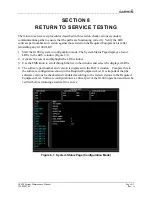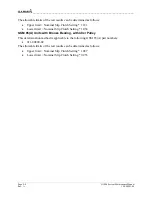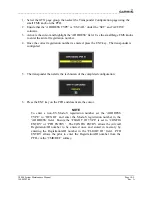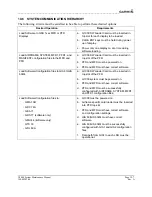
____________________________________________________________________
Page 9-6
G1000 System Maintenance Manual
Rev. A
190-00903-00
12.
At the completion of the test, the MFD will display one of the following CAS messages:
a.
CLUTCH [PIT/ROL/YAW] PASS
b.
CLUTCH [PIT/ROL/YAW] FAIL
13.
Press the red AP DISC button to relieve any control tension.
14.
Press the ENT key to acknowledge the COMPLETE prompt on the PFD.
15.
If the CAS message CLUTCH [PIT/ROL/YAW] PASS is displayed, the test has passed.
If the CAS message CLUTCH [PIT/ROL/YAW] FAIL is displayed, the servo must be
removed from the aircraft and tested/adjusted per the in Section 9.7.
16.
Record whether the test result (pass or fail, from the CAS messages displayed on the
MFD) and the clutch measurement values (from PFD1) in Table 9-2, or in appropriate
aircraft maintenance records.
17.
Repeat this procedure for each servo axis.
NOTE
The Min and Max Torque values displayed on the GFC Status Page should not
be used to determine whether or not the test passed. Only the appearance of the
CAS message CLUTCH [PIT/ROL/YAW] PASS on the MFD should be relied
on as an indication that the test passed in a given axis.
Table 9-1. Test Results
Axis Direction
Min
Measured
Torque (in-
lbs)
Max
Measured
Torque (in-
lbs)
Min Allowed
Torque (in-
lbs)
Max
Allowed
Torque (in-
lbs)
Pass or
Fail
Up
Pitch
Down
TBD TBD
Left
Roll
Right
TBD TBD
Left
Yaw
Right
TBD TBD
Min/Max Test Threshold Determination
In order to account for individual GSA 8X load cell measurement tolerance, as well as possible
GSM 85(A) slip clutch variation over temperature, specific minimum and maximum torque
limits must be established for each axis. To establish these thresholds, Garmin has developed a
procedure that yields a 99% confidence level based on a significant sample size of fielded and
production units. These thresholds vary based on whether the applicable GSM 85(A) contains
either a ball bearing or a bronze bearing on its output shaft, and also whether or not the GSM
85(A) has an idler pulley.






























